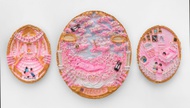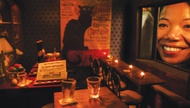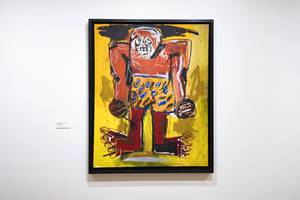
KD Matheson: Masks, Sculptures, Paintings Through August 27; Monday-Thursday, 10 a.m.-8 p.m.; Friday-Sunday, 10 a.m.-6 p.m.; free. The Studio at Sahara West Library, 9600 W. Sahara Ave., 702-507-3630.
Strange spirits are stirring in KD Matheson’s Masks, Sculptures, Paintings at Sahara West Library through August 27. Featuring 37 sculptures and large-format paintings, the exhibition is an encyclopedia of symbols—some recognizable, some disturbing, some comic and poignant by turns. Matheson’s strength as an artist partly resides in his ability to glide from one set of symbolic references to the next—from Aztec, say, to Medieval Christian, or from the dreamy terrain of surrealism to the natural world. The result is quirky, disarming work that seems to belong to the jungles of Borneo on one hand and the sci-fi frontier on the other.
Restraint is key. To control the profusion of symbolic forms, Matheson often limits his palette to black, white and sienna. His mark-making, too, is largely confined to heavy contours and strong, patterned surfaces. Even more importantly, the symbolic forms and shapes multiplying before the viewer’s eyes are actually variations on a small vocabulary of geometrical shapes. These stylistic choices, among others, prevent most of Matheson’s symbol-laden works from having a shopworn feel, instead propelling them into fresh, Expressionist terrain. Revitalized symbols, whether from pagan or established religions, lend an edgy, intriguing air to Matheson’s content.
Take, for example, the ceramic “Corvus” (2015). It looks at first like a canopic jar—an urn used by ancient Egyptians in the mummification process. Instead of an Egyptian deity topping the lid, Matheson substituted a bird’s head with a tribal, rather than pharoanic, feel. The sienna surface of the piece, with etched geometrical feathers, links to pre-Columbian sculpture, while the bird’s crown—a bony, cylindrical projection—recalls unique headwear worn by dancing dervishes. The bird’s enigmatic expression mirrors other beings in Matheson’s stable, while its texture, palette and headgear connect to various works, including the impressive “Azimuth” (2003), a 10-by-9-foot painting-on-paper resembling the innards of a starship engine. In “Azimuth,” the feather texture covers machine parts, while the bird’s crown relates to piping.
“Malabar,” one of the few chromatic works in the exhibition, is another standout. Its weird, bulbous parts recall the photographs of mainline Surrealist Hans Bellmer, while the deformation of the human body alludes to British giant Francis Bacon. In the switch to color, Matheson maintains flatness of the planes, reducing the background to hieroglyphic symbols or calligraphic marks. Fiery, bright forms dominate the composition, as if Malabar’s inner shamanic force were itself portrayed.
Masks, Sculptures, Paintings is both powerful and accomplished. As a mini-retrospective surveying 20 years of work, it convincingly speaks to the mastery of Matheson’s signature style. Run, don’t walk, to see it.






